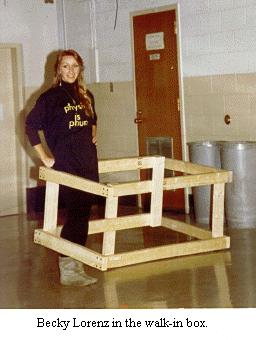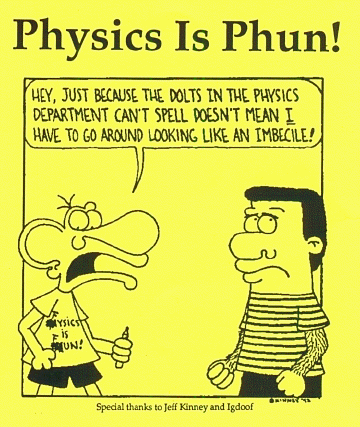

The University of Maryland Physics Department presents a series of free public lecture-demonstrations affectionately known as PHYSICS IS PHUN. Different programs are presented four times yearly, typically in early November, mid-January, mid-March, and early May, on dates governed by the University class calendar. The same program is presented on consecutive Thursday, Friday, and Saturday evenings. A flyer describing the present series of programs is shown at the end of this document.
The purposes of presenting these programs are: (1) They supplement the standard high school physics course by exposing the students to a large array of phenomenological physics background. (2) They encourage younger students to study science (and even physics) by developing the students' interest in physics. (3) They provide some background for the scientific culture in which we live. We live in a scientific and technological culture. Like many of the non- science disciplines, it may be important to expose people in an experiential manner to some of the great scientific principles on which this culture is built. With these aims in mind, we attempt to provide programs which are both interesting and entertaining, involve little or no mathematics, and inlcude an engaging sequence of physics demonstrations which adequately survey each area of physics.
The PHYSICS IS PHUN series has proved to be quite popular, with attendence of around 400 people per evening, for a total of nearly 5000 attendees yearly. Although the series originated for and is aimed at high school students, a number of students below high school age now attend regularly. Due to what we believe is interest derived from the compelling nature of physics demonstrations, a large number of adults attend the programs, including both high school and college teachers as well as scientists from area laboratories. PHYSICS IS PHUN has recently won an award of merit from the Maryland Higher Education Commission. If anyone else wants to give us an award, we will gladly accept, especially if it includes a large amount of money and a nice trip to an exotic location.
 Each program has two segments: a hands-on
interactive segment as the guests arrive, lasting from about 6.45 until 7:30
each evening, and a more formal lecture, lasting from 7:30 until about 8:45.
The hands-on segment is monitored by a group of students, staff, and community
volunteers, who interact with the visitors by helping people operate or observe
the demonstrations, asking provocative questions, and sometimes even providing
answers. As the volunteers arrive, we provide a modest pizza and soft drink
dinner, both as a way for the volunteers to meet each other and to bribe some
people (especially our physics students) into volunteering. Toward the
end of the meal, we gather in the lecture halls to review the pre-show demonstrations,
and each volunteer chooses one apparatus or area to supervise.
Each program has two segments: a hands-on
interactive segment as the guests arrive, lasting from about 6.45 until 7:30
each evening, and a more formal lecture, lasting from 7:30 until about 8:45.
The hands-on segment is monitored by a group of students, staff, and community
volunteers, who interact with the visitors by helping people operate or observe
the demonstrations, asking provocative questions, and sometimes even providing
answers. As the volunteers arrive, we provide a modest pizza and soft drink
dinner, both as a way for the volunteers to meet each other and to bribe some
people (especially our physics students) into volunteering. Toward the
end of the meal, we gather in the lecture halls to review the pre-show demonstrations,
and each volunteer chooses one apparatus or area to supervise.
The formal lecture-demonstration program typically covers some area of physics by illustrating each concept using a demonstration. We try to include some physics-related cartoons and perhaps other audiovisual materials in each program to break up the monotony of the demonstrations. A typical program includes about twenty demonstrations, with about another twenty used in the pre-show interactive segment.
Because the Physics Lecture-Demonstrations Facility possesses a large inventory of lecture-hall size demonstrations, it has been relatively easy to compile a collection of about sixteen different PHYSICS IS PHUN programs, covering virtually all areas of physics. We typically run the programs on about a three-year cycle, so that people can attend for about three years without seeing significant duplication. Some of the programs in our reportoire are:
 Good Vibrations
Good Vibrations
Vibrations, SHM, resonance and coupled oscillations.
Making Waves
Properties of waves, with applications to sound and light.The Sounds of Science
The overtone series, spectrum analysis, and applications to musical instruments and the voice.
Seeing the Light
Lenses, mirrors, and applications thereof.
Illusions
Illusions and magic tricks involving physics, primarily visual.
Energy and Motion
Center-of-mass, motion, and Newton's laws of motion
Going in Circles with Physics
Rotational physics, including angular momentum and coriolis phenomena
When You're Hot, You're Hot
Thermodynamics and applications
Electricity
Static Electricity, magnetism, and major laws of electromagetism
Water
Physical and electrical properties of water, including phase transitions and atmospheric phenomena
Inside The Atom
Atomic and nuclear structure, atomic spectra and nuclear radiation
It's Physics
Answers to physics questions often asked by my two sons when they were very young
The Physics IQ Test
A collection of counterintuitive brain-teaser physics questions asked of the assembled throngs and answered using physics demonstrations
A Potpourri of Physics
A miscellaneous collection of our favorite deomonstrations, generally chosen from among the topics not covered by recent programs
About twelve of the programs have been videotaped by the University cable TV group, and have been shown regularly on the UMCP Flagship Channel.
The following is the flyer sent to a mailing list of interested people early each school year. For questions or further information, please contact Dr. Richard Berg at rb22@umail.umd.edu or the mail or telephone address found on the HOME PAGE.
Doors open by 7:00 PM, Program 7:30-8:45 PM
DIRECTIONS: From Beltway Exit 25 south 1.9 miles on Route 1. Right at light at Campus Drive, proceed one long block and bear right at the "BIG M" traffic circle; Lecture Halls are 100 meters on right. Free parking is available at any non-metered space in the top levels of Parking Garage PG2, across the street from the Physics Lecture Halls, or in nearby surface lots which designate that parking is free after 4:00PM.
Supported in part by NSF-MRSEC grant #DMR96-32521.
For comments or constructive criticism of this document please e-mail Dr. Richard Berg, rb22@umail.umd.edu, or send comments by phone or to the mailing address on the home page.